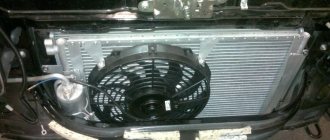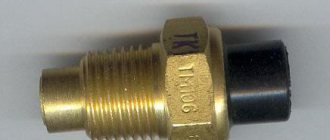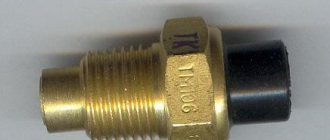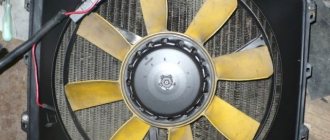Car : VAZ-2112. Asks : Kirillov Igor. The essence of the question : The cooling fan does not work, does not turn on at all, what should I do?
Hello! The fan on my VAZ-2112 stopped turning on. It so happened that the car simply boiled in a traffic jam, so I realized that the fan simply did not work. Tell me what could be the reason?
Symptoms of failure
But, like any other spare part of a car, the temperature sensor can fail. So, what malfunctions can occur if the sensor stops working:
- The cooling fan will run continuously.
- The cooling fan will not operate.
In the first case, the car will operate in emergency mode and a constantly turned on fan can cause the winding to burn out. In this case, the product will have to be changed completely. In the second case, the engine will begin to overheat and at a certain point will boil .
conclusions
The fan switch on sensor on the 16-valve VAZ-2112 engine is located on the cylinder head near the thermostat. So, its breakdown can lead to the fan stopping working and the engine not cooling properly, which in turn will lead to it boiling, and even more complex malfunctions may occur.
Car : VAZ-2112. Asks : Kirillov Igor. The essence of the question : The cooling fan does not work, does not turn on at all, what should I do? Hello! The fan on my VAZ-2112 stopped turning on. It so happened that the car just boiled in a traffic jam, so I realized that the fan simply did not work. Tell me what could be the reason?
Cooling system
Typically, the cooling system of any car consists of the following elements:
- radiator;
- BC cooling jacket;
- thermostat;
- connecting pipes and hoses;
- centrifugal pump;
- fan with electric motor.
And if some device malfunctions, then on a VAZ-2110 with an injector the cooling fan does not turn on.
Every element is necessary for the proper operation of the entire system, but the fan is still one of the important components. Its task is to cool the radiator and, accordingly, the liquid passing through it, when necessary. If it stops turning on, this affects the performance of the entire system.
Causes of malfunction
If the radiator fan refuses to start, check the items in the following order:
- Fuse - Check this fuse element for continuity in the fuse block. It is located there under the number F7 and has a rating of 20 amperes. The fan fuse is yellow F7. (editing machine mounting block, 124 engine)
- The relay responsible for the operation of the electric fan is located, together with additional relays, next to the left foot of the front passenger. The easiest way to check is by connecting a known good relay. If after such dismantling everything works, the problem is solved, if not, then read below. The relay is located under the number “4”.
- Thermostat - since the liquid first circulates in a small circle without heating the sensor and radiator. It is easy to check if the thermostat is malfunctioning; just touch the two pipes going to the radiator; if one of them is cold on a well-warmed engine, then the thermostat is faulty and needs to be replaced.
- Temperature sensor - to diagnose a malfunction of this element, on a warm engine, disconnect the power connector from it, thereby you will force the fan motor to start. If it still does not start, then the problem lies in the electric motor itself. It is worth checking the sensor and replacing it if necessary.
- Fan motor - in order to check this element, you need to disconnect the power supply and connect it directly to the battery. If the fan is working, it will start, and if it fails, look for a problem in the wiring or change the fan assembly. You can try to repair the electric motor.
When all of the above methods did not bring the desired result, you need to look for the reason only in the wiring, “ringing” them one by one. Perhaps there was a break or break in the wire somewhere.
The electric motor of the fan, the engine cooling system of the VAZ-2112 car, is switched on through a relay . And it is triggered by a command from the electronic control unit, which receives a signal from the fan activation sensor. It is located just above the thermostat. It should not be confused with the coolant temperature sensor, which works with the temperature gauge located on the instrument panel. It is located below the fan sensor.
Fuse, motor and relay
You should look for the cause of overheating, starting with checking the fuse and fan relay. The first of them is located in the mounting block of the engine compartment. There it is labeled F7 (20A). You need to take it out and visually assess its integrity or use a multimeter.
In most cases, the cooling fan of the VAZ-2110 (injector, 8 valves) does not turn on precisely because of the fuse, since the control signal does not pass through. It is worth taking it out and visually assessing its integrity or using a multimeter. If necessary, replace it immediately; otherwise, you should look for the cause elsewhere. And in the meantime, it’s worth checking the fan itself. To do this, disconnect the fan connector and connect the electric motor directly to the battery through the wires, not forgetting the polarity.
If the drive is in order, then you should head to the interior, since this is where the relay is located. Its more accurate location is another mounting block on the left side relative to the front passenger’s feet. Of the three relays, the one on the left is the one you need. To perform the test, you need to install another relay in place of the old one. After this, start the car and wait for it to heat up to maximum temperature, while simultaneously watching the fan. If there is no result, the search continues.
Sensor for turning on the fan of a VAZ 2110 car
Internal combustion engines are far from perfect, so most of the energy consumed during the operation of such units is released in the form of heat. In the winter season, this “by-product” can be successfully used to maintain optimal air temperature in the cabin, but in the summer this is not necessary, so antifreeze can boil even after a short period of operation of the internal combustion engine. When the coolant heats up to a certain value, the fan automatically turns on and the coolant temperature returns to normal. The VAZ 2110 fan switch-on sensor, with the help of which the forced cooling of the internal combustion engine is timely activated, will be discussed in this article.
Sensor
The Internet today can bring significant help. On some forums you can find owners asking why the VAZ-2110 cooling fan with an injector does not turn on. The reasons and photos are discussed by several people, who mainly refer to the sensor.
To check it, start the engine and wait until the coolant warms up to operating temperature. After this, you need to disconnect the sensor connector, the controller will detect an open circuit and switch the fan operation to emergency mode. If it works, then the reason lies in the sensor. It is worth replacing it and checking it again to be sure.
Design and principle of operation
The VAZ 2110 fan sensor, both 8 and 16 valves, consists of a sealed housing, inside of which there is a bimetallic plate and electrical contacts. A feature of the working element is the possibility of significant physical expansion when heated. When the temperature changes significantly upward, the plate expands and the thermal relay contacts close.
On the outside of the housing, a thread is cut, which is necessary for reliable fixation of the sensor in the cooling system of the internal combustion engine. On the opposite side of the sensor, terminals are installed that are necessary for connecting the contact wires.
Symptoms of a problem
If the engine boils, and the characteristic hum of the cooling system fan is not heard, then with a high degree of probability one can suspect the presence of a malfunction of the internal combustion engine. The opposite situation, when forced cooling operates as long as the ignition is on, will also indicate a problem with the automation. On a VAZ 2110 injector, a constantly switched on fan sensor may indicate problems with the controller. The control unit could “remember” an error that appeared earlier and, as a result, the electric motor is activated every time it is started.
Periodic turning on and off of the fan when the engine is not yet warmed up is also a sure sign of an imminent failure of the combustion engine.
Important Functional Purpose
In order for the internal combustion engine to operate effectively, it is necessary to maintain a certain temperature regime. This task is provided by the cooling system, which sometimes malfunctions. In this case, engine overheating cannot be avoided, resulting in failure of the cylinder head gasket and CPG parts.
To understand why the cooling fan does not turn on on a VAZ-2110 with an injector, you need to know how it works. In good condition, the optimal temperature of the antifreeze in the engine is maintained, which prevents boiling. If you constantly ignore the breakdown of any element, then after an indefinite period of time a major repair will be required. And this already promises considerable costs, but this can be avoided!
In most cases, the cause of one or another engine malfunction is its overheating. The temperature in the cylinders after combustion of the air-fuel mixture reaches 2000 °C. This generates a colossal amount of heat, which, if not removed, has a detrimental effect on some important parts. After all, as is known, strong heating leads to significant deformation of objects.
Where is
Drivers who have never encountered a malfunction in forced engine cooling before may not know where the internal combustion engine is located. On a carburetor VAZ 2110, this element of the cooling system is located on the radiator. If the driver finds this part, then he can easily find the fan switch sensor, which is located on the side. A characteristic feature of the product is the electrical wires connected to it. On the injection VAZ 2110, this part can be found on the cylinder block.
The sensor located in this way allows you to respond promptly to changes in coolant temperature. In addition, access to this part is not difficult and you can immediately begin repair or diagnostic measures if there are doubts about its performance.
Procedure. Step-by-step instruction
If after completing the next step the problem goes away, further checks are stopped.
- Open the hood.
- Wait for the engine to cool down.
- Perform an initial visual inspection: integrity of the hoses, reliability of the clamps, absence of leaks or cracks.
- Make sure that the expander cover elements are in good condition. Remove scale, rust, clear holes, wipe, assemble. The absence of noticeable damage to parts gives hope that the product will work.
The valve design is elementary. The cover contains a spring. Functionally, it is designed to regulate the pressure in the cooling circuit. A hot engine increases it, a cold engine decreases it.
Compressing at a value of 1.1 atmospheres, the spring relieves excess pressure and prevents the destruction of hoses and the tank. As the motor cools, it creates a vacuum effect. The tank will begin to flatten. The valve equalizes the pressure.
The lid screws tightly on the thread, eliminating distortions. There should be a gap between it and the body. An overtightened valve will not work. It is difficult to test the device's operation in road conditions. You can check by replacing it with a known good one.
Inspect the electrical wiring elements to ensure a reliable connection
Possible factors for damage to electrical circuits:
- vibration;
- oxidation;
- burning;
- breakage, fraying of electrical wires;
- insulation aging, short circuit.
Switch the tester to resistance measurement mode. Remove it with special tweezers and ring the fuse link F7 located in the mounting block.
Fuse box diagram
Attention! It is important to find out and eliminate the cause of burnout.
Replace the burnt-out element with a serviceable one with a rating of 20A. Inspect and clean the nest. Insert fuse.
It was not possible to find out the reason, the protection triggered again - look for a short circuit.
How does the engine cooling system work? Diagram
Disconnect the fan plug. Use a tester to measure the circuit of the electric motor windings. Zero resistance or a break indicate the need to replace the radiator blower electric drive.
Interturn short circuits that cause multiple replacements of fuse links cannot be measured with the device.
Sensor check
Start the car. Pull out the coolant temperature sensor connector. The fan starts working - the sensor needs to be replaced. Secure the disconnected wire. Drive to a nearby service station.
Relay test
There is a hatch on the floor at the front passenger's feet.
Below it is a built-in panel with three relays of the same type:
- fan installation;
- fuel pump;
- ignition (main thing).
By replacing each other, try to start the airflow. The VAZ 2110 fan does not work - go to the next step.
Where is the VAZ 2110 cooling fan relay located?
If you are wondering where the fan relay is located on a VAZ 2110, then this photo below will answer your question and you can easily find where the cooling fan relay is located on a VAZ 2110.
VAZ 2110 fan relay
Check the electric motor
Winding measurements did not reveal a malfunction. Apply voltage briefly from the battery using additional insulated conductors. The operation of the fan indicates a malfunction of the controller, which does not output a signal to the relay.
- The only correct solution is to turn on the airflow directly and urgently visit a service station.
- Prevention of breakdowns of the cooling system of the VAZ 2110 injector 16 valves.
- Periodically inspect the components of the cooling system.
- Monitor the cooling temperature on the device, listen to the operation of the fan.
- Maintain coolant level. Replace after 2 years or 30,000 km.
- Use the solution to remove rust and scale.
- Signs of a change in the properties of the coolant are a change in color, an increase in fluidity.
- Check the density with a hydrometer.
- Do not mix coolants.
- Every twelve months, rinse the expansion tank cap with water and check it on a stand with a pressure gauge.
- Avoid contact of aggressive liquids with electrical wiring and electric motor windings.
Improvements to the fan start control circuit for the VAZ 2110 injector
The smooth functioning of the engine worries factory designers, auto mechanics, and car enthusiasts. Folk craftsmen change the design of valves and electrical circuits.
Installation of three position toggle switch:
- continuously on: the VAZ 2110 cooling fan does not work;
- constantly switched off: warming up the engine when starting in the cold season, automatic control is faulty;
- automatic mode: controlled by the controller, the equipment is working properly, the algorithm is executed correctly.
When choosing an installation location, consider the following conditions:
- prevent accidental switching;
- not to be confused with other controls.
It is important to remember when modifying the design about the safety of the changes made.
How to replace
The fastest and easiest way to find out the reason for the fan not turning on or running continuously is to replace the DVV with a known good product. To avoid further confusion, it is not recommended to use used products, as well as sensors purchased from unverified retail outlets.
To carry out work on replacing the internal combustion engine, it is necessary to prepare a new part, a set of wrenches, rags and a container for collecting coolant. The process of removing the old part and installing a new sensor is as follows:
- Place the car on a level surface.
- Disconnect the negative terminal of the battery.
- Unscrew the cap of the expansion tank.
- Disconnect the wires from the DVV.
- Place a wide container under the engine to collect coolant.
- Using a 30mm wrench, unscrew the faulty part.
- Install a new DVV.
- Connect wires to the sensor.
- Pour coolant into the expansion tank.
- Close the lid.
- Connect the battery.
After starting the engine, it must be allowed to run for 15–20 minutes. During this time, the coolant temperature will reach a level at which the thermal relay contacts close and the fan will begin to rotate.
Expansion tank
If the cooling fan of a VAZ-2110 with an injector does not turn on, repairing it can still wait, since the whole problem may be in the valve of the expansion tank cap. Water, which is part of antifreeze, is known to boil at 100 °C under normal atmospheric pressure. It is for this reason that a higher pressure level is maintained in the cooling system, and then the liquid begins to boil at 107 °C, which is exactly the value the sensor responds to.
If the valve is faulty, the pressure is equal to atmospheric pressure, and the liquid boils at 100 °C instead of 107 °C, which the sensor does not “see”, although the entire system is working. You can only check the condition of the cover visually, but it is unlikely that you will be able to accurately assess its condition in your garage. Therefore, if you suspect a malfunction, it is better to immediately replace the old cover with a new one.
Diagnostics of VDV
If, as a result of replacing the sensor, the functionality of the cooling system is not restored, then the new part may be defective.
To make sure that the DVV is working, you need to perform the following simple steps:
- Remove the sensor from the car.
- Place it in a metal container with water.
- Place the tank on the gas stove.
- Boil.
- Remove the DVV from the container and measure the resistance between the contacts.
Tips and tricks
During the diagnostic operations and replacement procedure, some difficulties may arise that you should be aware of in advance, for example:
- The sensor may be fully operational and the wiring intact, but the fuse installed in this electrical circuit may fail. It is also recommended to replace this part with a new one in order to exclude it from the list of possible “culprits” for the fact that the VAZ 2110 fan does not turn on.
- You can diagnose the fan switch sensor without a multimeter or tester. It is enough to assemble an elementary circuit with a current source, a light bulb and a series-connected DVR, which will serve as a thermal switch.
The process of replacing the DVV VAZ 2110 is simple, so even if you have no experience in performing such work, you can perfectly perform this operation the first time without outside help.
Where is the fan switch on sensor on the 16 valve VAZ-2112
Many motorists remember that due to a faulty fan switch sensor, the car began to boil in the summer. On new generations of cars, this indicator was moved from the left side of the radiator to the head of the block for effective recognition of engine and coolant temperatures. But, all the same, many motorists do not know where this sensor is located on the 16-valve VAZ-2112 engine.
Fan sensor: where and why?
The VAZ-2112 is equipped with a bimetallic sensor marked TM-108.
Fan sensor location
It is located on the cylinder head on the right near the thermostat. It connects directly to the engine's electronic control unit, where it sends all data on the operating temperature.
Symptoms of failure
But, like any other spare part of a car, the temperature sensor can fail. So, what malfunctions can occur if the sensor stops working:
- The cooling fan will run continuously.
- The cooling fan will not operate.
In the first case, the car will operate in emergency mode and a constantly turned on fan can cause the winding to burn out. In this case, the product will have to be changed completely. In the second case, the engine will begin to overheat and at a certain point will boil .
Fan check
Checking the fan motor
The fan needs to be removed. Get to the motor, close it directly and see if the fan works.
How to check the sensor at home
In order to check the fan switch sensor, you need to unscrew it from its mounting location and close the contacts using a tester. If there is no resistance, then the part is “dead”. The same procedure must be done with the wires. They need to be closed and the engine started. If the fan does not turn on at a temperature of 103 degrees Celsius, then you should look for the problem elsewhere.
Video about replacing the fan switch sensor
The video will tell you about the engine cooling system, nuances and repair methods
Consequences of engine overheating
People and cars are similar in some ways. The healthiest person, being under the hot sun and without a hat, risks receiving a noticeable blow that will knock him down. A machine, of course, is stronger than a person, but it also has its limits.
When the engine temperature exceeds the norm, a destructive process begins.
Before you understand why the cooling fan on a VAZ-2110 with an injector does not turn on, you need to know about the consequences of overheating. Moreover, its degree depends on the stage:
- weak degree;
- average degree;
- strong degree.
Slight overheating of the engine (no more than 5-10 minutes) does not pose any threat, since any experienced driver will quickly react to the situation and turn off the engine. The worst that can happen is the pistons melt, but most modern cars won't have any problems due to mild overheating.
Average overheating (more than 20 minutes) already has a significant impact on the engine. An approximate list of troubles that may follow:
- cylinder head curvature;
- the appearance of cracks in the cylinder head;
- burnout of cylinder head gaskets;
- destruction of interring partitions;
- passing oil through the seals.
However, this is not the worst thing that can happen.
Severe overheating is a real threat to the engine. And we are not talking about the fact that the cooling fan of the VAZ-2110 with an injector does not turn on, but about much more serious things. All engine parts are damaged, sometimes even an explosion is possible. But this happens infrequently, since the car itself protects itself: each part has its own rate of destruction, and for this reason the engine simply turns off.
The destructive wave begins its movement from the combustion chambers and gradually affects all engine parts:
- The pistons begin to melt and burn out.
- Melted pieces of aluminum pistons touch the cylinder walls, which makes the piston stroke very difficult, which leads to their further destruction.
- If the engine continues to operate, then the oil begins to lose its lubricating properties.
- Due to overheated oil, all rubbing parts begin to collapse.
- The connecting rod and main bearings begin to melt.
- Under the influence of the pistons, the crankshaft breaks into two parts.









